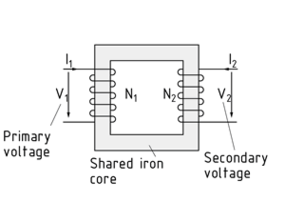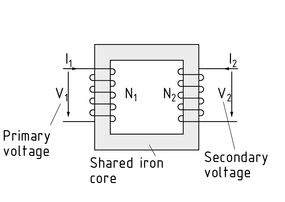
Seleccione uno
o más idiomas
0,1,3
- Alemán
- Inglés
- Chino
- Español
Transformador

Un transformador comprende esencialmente dos bobinas ( $N_1$ , $N_2$ ) y un centro de hierro hecho de láminas de metal aisladas, diseñadas para reducir las corrientes parásitas. El embobinado conectado al suministro es conocido como embobinado principal, el del lado de la salida es el embobinado secundario. Un transformador se usa para convertir la amplitud de la corriente alterna sin cambiar la frecuencia. La bobina principal genera un flujo magnético $\Phi $ en el centro de hierro, lo que induce a un voltaje en la bobina secundaria. ${U_1}/{U_2} = {N_1}/{N_2} = {I_2}/{I_1}$ aplica a los transformadores libres de pérdida. Los voltajes son proporcionales a los embobinados, la corriente es inversamente proporcional a esto y la energía transmitida es idéntica en los lados primario y secundario.
Los transformadores de fase única se usan con mucha frecuencia en aparatos electrodomésticos. Sin embargo, también juegan un rol importante en los sistemas de control de plantas las cuales son operadas con voltajes extremadamente bajos por razones de seguridad. En los paquetes de energía para equipos electrónicos, cada vez se usan más suministros de energía de modo interruptor en lugar de transformadores convencionales. Otras áreas de aplicación incluyen el aislamiento eléctrico de fuentes de voltaje y la transmisión de señal.
Los transformadores trifásicos se usan principalmente en la ingeniería de potencia.
Transformador de fase única
Transformator

Ein Transformator besteht prinzipiell aus zwei Spulen (N1, N2) und einem Eisenkern, der zur Reduktion von Wirbelströmen aus isolierten Metallblechen zusammengesetzt wird. Die netzseitig angeschlossene Wicklung wird als Primärwicklung, die Ausgangsseite als Sekundärwicklung bezeichnet. Mit einem Transformator lassen sich Wechselspannungen in Wechselspannungen gleicher Frequenz, aber anderer Amplitude umwandeln. Die Primärspule erzeugt im Eisenkern einen magnetischen Fluss $\Phi $, der eine Spannung in der Sekundärspule induziert. Beim verlustfreien Transformator gilt ${U_1}/{U_2} = {N_1}/{N_2} = {I_2}/{I_1}$. Die Spannungen verhalten sich proportional zu den Windungen, der Strom verhält sich antiproportional hierzu, die übertragene Leistung ist auf Primär- und Sekundärseite identisch.
,,,Einphasentransformatoren kommen sehr häufig in Haushalts-Elektrogeräten zum Einsatz. Transformatoren spielen aber auch bei Anlagensteuerungen eine große Rolle, die aus Sicherheitsgründen mit einer Schutzkleinspannung betrieben werden. In Netzteilen von Elektronikgeräten lösen vermehrt Schaltnetzteile den klassischen Transformator ab. Weitere Anwendungsbereiche sind die galvanische Trennung von Spannungsquellen und die Signalübertragung.
In der Energietechnik kommen hauptsächlich Drehstromtransformatoren zum Einsatz.
Transformer

A transformer essentially comprises two coils (N1, N2) and an Iron core made up of insulated metal sheets designed to reduce eddy currents. The winding connected to the mains is known as the primary winding, the one on the output side is the secondary winding. A transformer is used to convert the amplitude of alternating current without changing the frequency. The primary coil generates a magnetic flux $\Phi $ in the iron core, which induces a voltage in the secondary coil. ${U_1}/{U_2} = {N_1}/{N_2} = {I_2}/{I_1}$ applies in loss-free transformers. The voltages are proportional to the windings, the current is inversely proportional to this, and the transmitted Power is identical on the primary and secondary sides.
Single-phase transformers are used very frequently in electrical household appliances. However, they also play an important role in plant control systems, which are operated with extra-low voltage for safety reasons. In power packs for electronic equipment, switch-mode power supplies are increasingly being used in place of conventional transformers. Other areas of application include the electrical isolation of voltage sources and signal transmission.
Three-phase transformers are mainly used in power engineering.
变压器

变压器实质上包括两个线圈( $N_1$ , $N_2$ )和绝缘金属片组成的铁芯(目的是为了减少涡流)。连接电源的线圈被称为初级线圈,连接输出端的被称为次级线圈。变压器用于改变交流电的振幅,但不改变频率。初级线圈在铁芯上产生磁通量 $\Phi $,引导次级线圈产生电压。无损耗变压器中适用公式 ${U_1}/{U_2} = {N_1}/{N_2} = {I_2}/{I_1}$ 。 电压正比于线圈匝数,电流反比于线圈匝数,初级线圈和次级线圈上的输送功率是相同的。
单相变压器在家用电器中频繁使用。因为其操作电压低,所以出于安全因素,它们在工厂控制系统中也具有重要作用。电子设备的供电组越来越多地使用开关式电源来代替传统变压器。其他应用领域包括电压源和信号传输的电隔离。
三相变压器主要用于电力工程。
单相变压器
近义词
单相变压器
